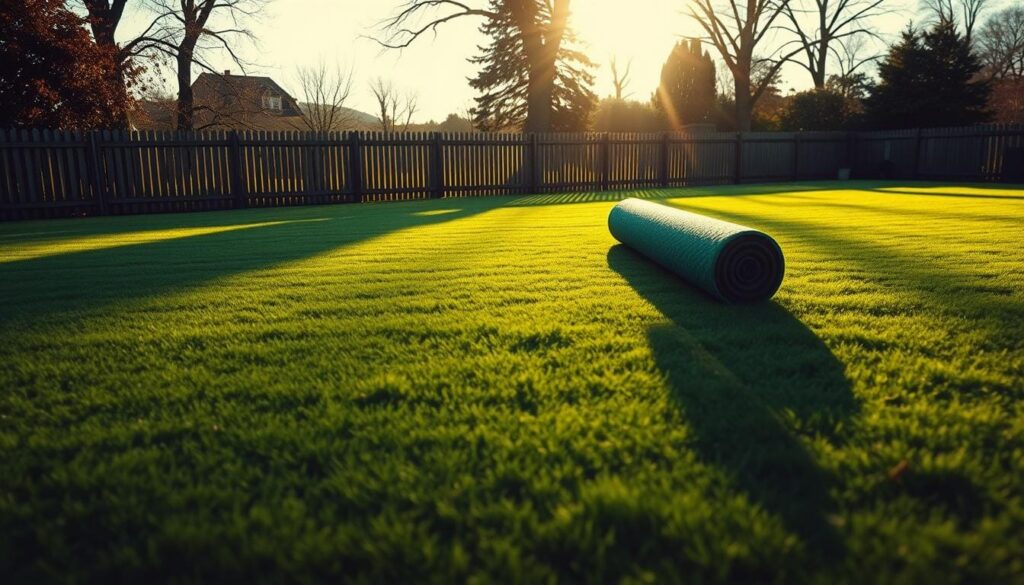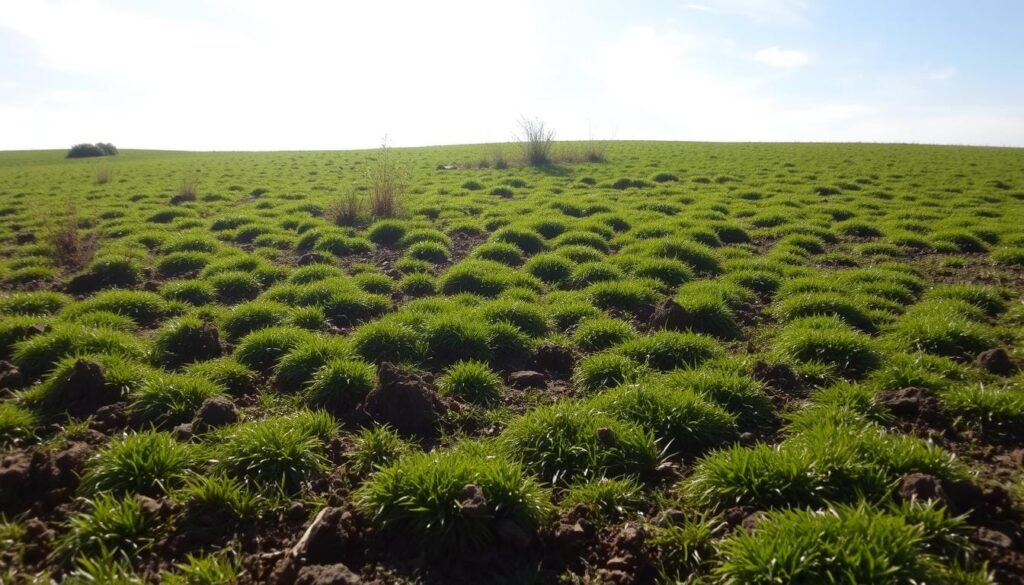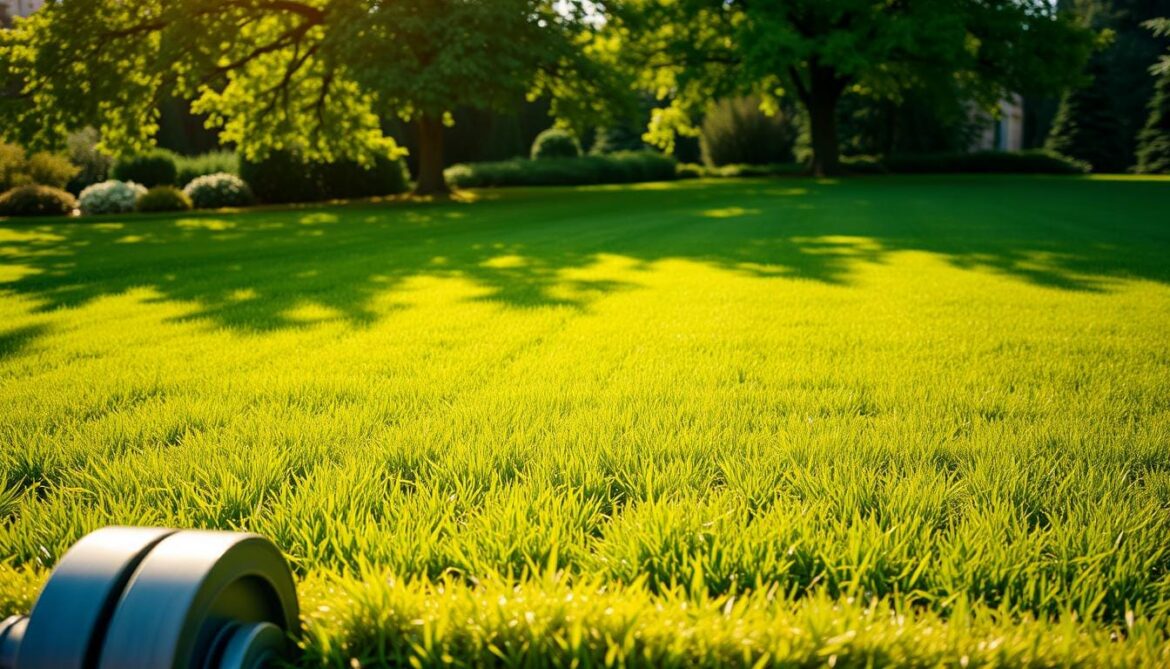A lush, healthy lawn is a homeowner’s pride. However, achieving that perfect, smooth lawn can be a challenge. Lawn irregularities caused by frost heaving or high-traffic areas can be frustrating.
Fortunately, expert lawn care professionals have techniques to help. Lawn rolling is a maintenance technique that can flatten the top one to two inches of soil surfaces, rendering them smooth and level. By understanding the science behind lawn rolling, you can avoid common mistakes that damage your turf’s long-term health.
Key Takeaways
- Understand the concept of lawn rolling and its benefits
- Learn when to roll your lawn for optimal results
- Discover the ideal equipment and techniques for lawn rolling
- Identify common lawn problems that rolling can and cannot fix
- Explore alternative methods for addressing lawn unevenness
Understanding Lawn Rolling: Purpose and Benefits

To understand the importance of lawn rolling, it’s essential to grasp its purpose and benefits. Lawn rolling is a simple yet effective technique that can significantly improve the health and appearance of your lawn.
What Is Lawn Rolling and Why It’s Done
Lawn rolling involves using a heavy roller to flatten and smooth out the lawn surface. This process is typically done after seeding or laying sod to improve soil contact and retention. By compacting the soil slightly, rolling promotes strong root growth as the roots grow deeper in search of water and nutrients.
The Benefits of a Properly Rolled Lawn
A properly rolled lawn offers numerous benefits, including:
- A smooth, even surface that enhances both the aesthetic appeal and functionality of your outdoor space.
- Improved seed-to-soil contact after seeding, which increases germination rates and promotes uniform grass growth.
- Elimination of air pockets between the sod and soil when installing new sod, encouraging faster root establishment.
- Better water distribution across the lawn, preventing pooling in low spots and ensuring more efficient irrigation.
- Correction of minor unevenness caused by frost heaving.
- A more comfortable surface for recreational activities and foot traffic.
- Deeper root growth, resulting in a more drought-resistant lawn.
By understanding the purpose and benefits of lawn rolling, homeowners can take a proactive approach to maintaining a healthy, beautiful lawn. Regular lawn rolling, when done correctly, can lead to a lush, vibrant turf that enhances the overall appeal of your property.
When to Roll Your Lawn for Optimal Results
Rolling your lawn at the right moment can significantly enhance its appearance and health. Lawn rolling is a technique used to improve the soil’s contact with the sod or seed, promoting healthy growth.
Ideal Seasonal Timing for Lawn Rolling
The ideal time to roll your lawn depends on the season and the type of lawn care activity you’re undertaking. For most lawns, rolling can be done during the growing season when the grass is actively growing. Early spring or fall are typically good times as the weather is mild, and the lawn is not under stress.
Soil Moisture and Temperature Considerations
Soil moisture and temperature play crucial roles in determining the best time to roll your lawn. It’s best to roll when the soil is moist but not waterlogged, as this allows for good soil contact without causing compaction. Avoid rolling during extreme temperatures.
Special Circumstances: New Sod and Seeding
For new sod installations, rolling immediately after laying helps eliminate air pockets between the sod and soil surface, ensuring good contact and promoting root growth. When seeding, light rolling helps ensure seed-to-soil contact, which is essential for successful germination. For overseeding, rolling afterward helps press the seeds into the soil without burying them too deeply.
- Roll new sod to increase soil contact and root establishment.
- Use light rolling for newly seeded areas to ensure good seed-to-soil contact.
- Avoid over-rolling, as it can compact the soil and hinder growth.
The Proper Rolling Lawn Technique

A well-rolled lawn is a hallmark of meticulous lawn care, but it requires the right technique. To achieve a beautifully manicured lawn, one must understand the nuances of lawn rolling, including the appropriate equipment and the process itself.
Choosing the Right Lawn Roller Equipment
Selecting the appropriate lawn roller is crucial for effective lawn rolling. The type of roller you need depends largely on your soil type and the specific task at hand. For most residential lawns, a water-filled roller is versatile and effective. It’s essential to start with an empty, lightweight roller and add weight as needed.
Step-by-Step Rolling Process
To roll your lawn effectively, begin by assessing your lawn’s condition and determining the desired outcome. If you’re addressing minor unevenness, a roller filled to about 1/3 capacity with water (approximately 150-200 pounds) is often sufficient. The rolling process should be done in a pattern, typically in one direction and then perpendicular to that direction to ensure evenness.
Weight Considerations and Adjustments
The weight of the roller is critical and depends on your soil type. For clay soils, use minimal weight (under 200 pounds) to avoid compaction damage. Sandy soils can tolerate slightly heavier rollers (up to 300 pounds). Always start with the minimum weight necessary and adjust as needed. Consider using sand instead of water in cold weather to prevent freezing, though this makes the roller heavier.
Potential Problems and When Not to Roll

While lawn rolling can be beneficial, it’s crucial to understand its potential drawbacks. Lawn rolling, if not done properly, can lead to several issues that might compromise the health and appearance of your lawn.
Soil Compaction Risks and Consequences
One of the significant risks associated with lawn rolling is soil compaction. Soil compaction can occur when the weight of the roller compresses the soil, reducing the pore space and potentially damaging the root system of the turfgrass. This is particularly problematic in clay-type soils, which are more prone to compaction. The consequences can include poor drainage, reduced air circulation, and increased susceptibility to disease and pests.
When Rolling Won’t Fix Your Lawn Issues
It’s also important to recognize that rolling won’t fix all lawn issues. For instance, if your lawn has deep-seated problems such as significant thatch buildup, rolling will not address these issues. In some cases, rolling might even exacerbate the problem, particularly if the lawn has a high percentage of fine fescues or is composed of mixed-grass types that respond unevenly to rolling.
Lawn Types That Respond Poorly to Rolling
Different types of grass respond differently to lawn rolling. Cool-season turf grasses with deep roots generally fare better than warm-season grasses that spread through rhizomes, such as Bermuda grass and Zoysia. Lawns with newly established or immature root systems should also avoid rolling until they have had at least one full growing season to develop.
| Lawn Type | Response to Rolling |
|---|---|
| Cool-season turf grasses | Generally more resilient |
| Warm-season grasses (e.g., Bermuda, Zoysia) | Can be damaged by heavy rolling |
| Newly established lawns | Should not be rolled until mature |
As noted by turfgrass experts, improper use of lawn rolling can kill turf grasses that spread through rhizomes. Therefore, understanding your lawn’s specific needs and limitations is crucial before deciding to roll.
“The key to successful lawn rolling lies in understanding the type of grass and soil you’re working with.”
Alternative Methods for Fixing an Uneven Lawn

Beyond rolling, there are several approaches to fixing an uneven lawn. While lawn rolling can be effective for minor issues, more significant problems may require alternative solutions. Landscapers have a variety of techniques at their disposal to address unevenness.
Aeration and Topdressing Techniques
Aeration involves creating small holes in the soil to improve airflow, reduce soil compaction, and promote healthy drainage. Following aeration, topdressing with a mixture of soil, sand, and organic matter can help level the lawn surface. This combination of techniques can be particularly effective for lawns with minor unevenness.
Addressing Root Causes of Lawn Unevenness
To effectively address lawn unevenness, it’s crucial to identify and address the underlying causes. Common issues include soil compaction, poor drainage, and settling soil. By understanding the root cause, homeowners can choose the most appropriate solution, whether it involves aeration, drainage improvements, or other corrective measures.
Professional Solutions for Severely Uneven Lawns
For lawns with significant unevenness, professional intervention may be necessary. Techniques such as grading, cut-and-fill, and installing drainage systems can be employed. Some of the methods professionals might use include:
- Regrading for severely uneven lawns with multiple deep depressions or raised areas
- Professional lawn renovation services using specialized equipment like laser graders
- Comprehensive drainage solutions, including French drains and dry wells
- Cut-and-fill techniques for targeted areas
Conclusion
Ultimately, incorporating lawn rolling into your lawn care routine can be a game-changer for homeowners and groundskeepers alike. Lawn rolling is a highly effective practice for enhancing the health, appearance, and resilience of your lawn. By understanding when to roll and how to do it correctly, you can promote strong root growth, reduce mowing frequency, and maintain uniform soil moisture.
To achieve the best results, remember that timing is crucial. Rolling in early spring when the soil is moist but not wet provides the best results with minimal risk of damage. For new lawns, rolling can help establish better seed-to-soil contact or help new sod root more effectively. Always consider your lawn care needs and the specific conditions of your turf before rolling.
By combining proper rolling techniques with comprehensive lawn care practices, you can achieve a beautiful, level lawn that enhances your property’s appearance and functionality.

